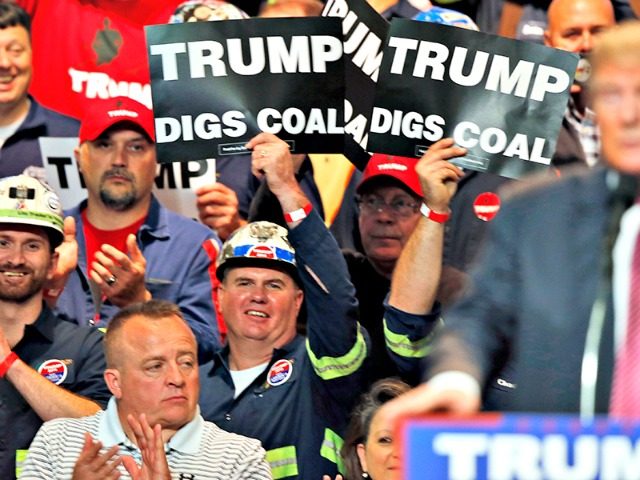The U.S. Environmental Protection Agency (EPA) filed a notice in the Federal Register that it is rescinding former President Barack Obama’s Clean Power Plan (CPP). This action serves as further evidence the gridlock in the Washington, DC swamp has not slowed President Donald Trump’s efforts to roll back ineffective and extremely costly climate programs and regulations.
The EPA’s decision was not unexpected. During the 2016 presidential campaign, Trump said the United States faces numerous problems more important than climate change, and he pledged to eliminate environmental policies hampering economic growth and domestic energy development, targeting the CPP by name. As part of Trump’s March 28 “Promoting Energy Independence and Economic Growth” executive order, Trump directed EPA Administrator Scott Pruitt to review CPP and rescind or revise it, if necessary, to promote the wise development of natural resources, unencumber energy production, and increase jobs.
The EPA based the decision to rescind CPP on three main principles: CPP is inconsistent with the 1970 Clean Air Act; CPP violated states’ authority to decide the best mix of power generation within their borders and eroded longstanding federal/state partnerships necessary to achieve environmental improvement; and enforcement of CPP would have had a devastating effect on jobs and raised energy costs for consumers—all while having virtually no effect on climate change.
CPP was the centerpiece of the Obama administration’s effort to move the United States away from the use of fossil fuels, beginning with coal, to fight climate change. CPP would require states to reduce carbon dioxide emissions by 32 percent below 2005 levels by 2030, on average.
To comply with the plan, states would have to force utilities to shutter dozens of coal-fired power plants prematurely. The Energy Information Administration projected CPP would result in $1.23 trillion in lost gross domestic product (GDP), in 2014 dollars, from 2020 to 2030, with an average annual GDP loss of $112 billion. Estimates indicate CPP would boost people’s electric bills 11–14 percent per year and cost more than 100,000 jobs in manufacturing and other sectors annually.
Despite these substantial harms, the Obama administration acknowledged in testimony before the U.S. House Committee on Science, Space, and Technology on July 9, 2015, that if the United States met CPP’s emission reductions targets, it would prevent, at best, one one-hundredth of one-degree Celsius of temperature rise by 2100. Talk about all pain and no gain!
Twenty-seven states, led by West Virginia, and several industry groups and trade associations challenged CPP’s legality in federal court. In February 2016, the U.S. Supreme Court took the unprecedented step of ordering a nationwide stay on implementation of CPP before it went into effect, pending the outcome of the legal challenges.
CPP would have dramatically raised energy costs in United States, harming the poorest among us more than the rest and putting U.S. industries at a competitive disadvantage in the global economy. By rescinding it, Trump is doing what he promised to do and what any president should do: putting America first. Bravo!
Having said this, unless Trump wants these gains to unravel, he has at least one more step to take. Environmental groups and some state government officials have already announced that if the CPP rescission is finalized, they will sue to block the Trump administration’s action to keep CPP on the books. In truth, this presents a problem for Trump.
CPP and the other climate regulations imposed by the Obama administration were justified based on the EPA’s determination carbon dioxide poses a threat to human health and the environment, a concept known as the “endangerment finding.” Relying on unsubstantiated projections produced by the Intergovernmental Panel on Climate Change, the EPA determined carbon dioxide emissions from cars and industry threaten human welfare.
To solidify his CPP action and other climate deregulatory efforts, Trump must direct the EPA to reconsider the endangerment finding by forcing the agency to demonstrate—through independent, validated research—carbon dioxide emissions are toxic (they aren’t at any foreseeable levels) or that global warming is causing measurable amounts of sea level rise, increased hurricane numbers or intensity, the spread of disease, or other harms attributable directly to carbon dioxide emissions in the United States. If the EPA can’t directly link such problems to U.S. carbon dioxide emissions (it can’t) or can’t show that such problems can be dramatically reduced by cutting U.S. carbon dioxide emissions (they won’t), the EPA should withdraw the endangerment finding.
Withdrawing the endangerment finding would eliminate the legal justification that has been used to impose a wide range of climate regulations. In the process, it would also end radical environmental activists’ ability to use the courts to impose policies on an unwilling public—one whose elected representatives have repeatedly rejected climate alarmism.
H. Sterling Burnett, Ph.D. (hburnett@heartland.org) is a research fellow on energy and the environment at The Heartland Institute, a nonpartisan, nonprofit research center headquartered in Arlington Heights, Illinois.

COMMENTS
Please let us know if you're having issues with commenting.